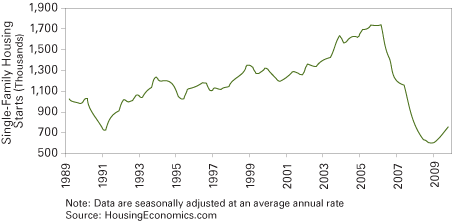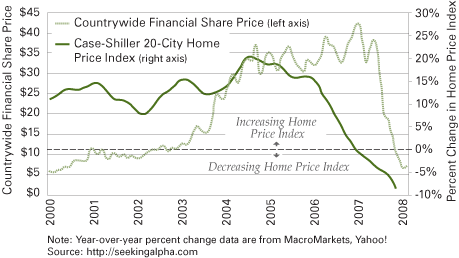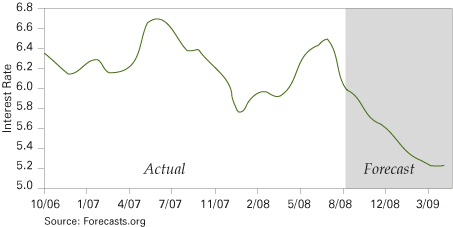Housing Market Outlook for 2009
Director, Benecki Center for Real Estate Studies; Charles H. and Barbara F. Dunn Professor of Finance and Real Estate, Kelley School of Business, Indiana University Bloomington
November 2008
The Blame Game
Needless to say, the housing industry has taken the blunt of the blame for the financial crisis and the current economic recession. Certainly, the unprecedented growth of subprime mortgages made to people who really couldn't afford a home was a major cause of the problems. It is questionable, at best, whether or not these mortgages were sound loans even when home prices were rising and people could refinance and take equity out of their home to help cover their future mortgage payments—especially when their “teaser” interest rates were adjusted upward to a market rate. When home prices started falling two years ago, millions of people holding these mortgages faced financial trouble. As defaults started to increase, concerns about the impact on banks and the rest of the economy swelled from a ripple to a tidal wave that swept away many financial institutions and resulted in the federal government taking over Fannie Mae and Freddie Mac.
There are certainly others to blame. Mortgage brokers encouraged homeowners to get mortgages they couldn't afford so the brokers could get fees. Lenders thought the mortgages were a good way to increase profits, and they got their service fees while selling the loans to Wall Street, who in turn created securities backed by the mortgages. The securities were rated by the rating agencies, which also received payments on fees, and then the securities were purchased by investors around the world who relied on the rating agencies. While not obvious at the time, it is now clear that the system failed us and the incentives were all wrong. Thus, we are all paying for it through the bailout and the effects the financial crisis has had on banks, retirement accounts, Main Street, and Wall Street. Small businesses have been having problems refinancing loans to keep their businesses going as banks have severely cut back on the amount they are willing to loan and tightened lending criteria to everyone—not just mortgage holders.
Bailout and Turnaround?
The bailout may help by restoring liquidity in the banking system, removing bad mortgages from banks' balance sheets, and encouraging banks to loan again. Moves by the Federal Reserve Bank to keep interest rates down may also help. And even if inflation comes back as a result, it could ultimately help push home prices back up again.
The question is, when will the housing market turn around? There are many outstanding mortgages whose artificially low interest rates will reset in 2009, which may result in continued foreclosures that put downward pressure on home prices. On the other hand, the drop we have already experienced in home prices has started to make prices attractive again and existing home sales actually increased slightly in recent months.
Still, most economists think it will be late in 2009 or 2010 before we see much of a recovery in the housing market. According to the National Association of Home Builders (NAHB), single-family housing starts are projected to bottom out during 2009 and then begin to climb. We anticipate the bottom reached in 2009 will be slightly below the level dropped to during the recession of the early 1990s, as seen in Figure 1.
Figure 1: Single-Family Housing Starts, 1989 to 2009

There is currently a ten-month supply of new homes on the market, compared to a six-month supply in 2006 before the housing crisis started. The good news is that sales of newly built single-family homes turned upward in September 2008, posting a 2.7 percent gain and marking a seasonally adjusted annual rate of 464,000 units, according to the U.S. Commerce Department. This suggests that builders are making progress in winnowing down the supply of unsold units on the market. However, the median number of months completed new homes stayed on the market moved up to 9.1 months—a new record. The level of confidence among builders surveyed in October for the monthly NAHB/Wells Fargo Housing Market Index fell to its lowest point since the series started in 1985, indicating concern among home builders as to when the market will recover.
Existing-home sales, including single-family homes, townhomes, condominiums, and co-ops rose 5.5 percent to a seasonally adjusted annual rate of 5.18 million units in September—up from 4.91 million in August. This is 1.4 percent higher than the 5.11 million–unit pace in September 2007.
The national median existing-home price for all housing types was $191,600 in September, down 9 percent from a year ago when the median was $210,500. Distressed sales are currently 35 percent to 40 percent of transactions. These are pulling the median price down because many are being sold at discounted prices.
Figure 2 shows the decline in home prices based on the Case-Shiller Home Price Index. The stock price of Countrywide Financial, one of the nation's largest mortgage lenders, is also shown. Hindsight is easy, but it is clear that home prices experienced a slowdown in growth before the stock market realized the impact this would have on mortgage lenders.
Figure 2: Countrywide Financial Share Prices and Year-Over-Year Percent Change in the Home Price Index, 2000 to 2008

Mortgage interest rates are likely to stay relatively low due to the lower demand for mortgages and the Fed lowering interest rates, although the higher risk attributed to mortgages is keeping rates from falling significantly. Figure 3 shows a forecast of thirty-year mortgage interest rates from Forecasts.org.
Figure 3: Thirty-Year Conventional Mortgage Interest Rate—Past Trend and Projection, 2006 to 2009

Housing Affordability
Due to the drop in home prices and continued low mortgage interest rates, housing has become more affordable. The National Association of Realtors Housing Affordability Index is now at 135, whereas it was only 106 in 2006. This indicates that the median income family now has 35 percent more income than necessary to qualify for a loan on a median priced home, compared to 6 percent more income than necessary in 2006. That said, the blowup in the subprime mortgage market means that those without very good credit ratings are not likely to receive financing even if their income is sufficient.
Conclusion
The recovery of the housing market is going to depend partly on how the credit markets adjust. Many lenders are now more willing to renegotiate loans for those facing foreclosure. However, the credit market can only do so much. We also need to restore faith in our financial system.
Also in this Issue…
- Outlook for 2009
- International Outlook for 2009
- U.S. Outlook for 2009
- Financial Outlook for 2009
- Housing Market Outlook for 2009
- Indiana's Outlook for 2009
- Indiana's Agricultural Outlook for 2009
- Indiana's Special Sectors Outlook for 2009
- Anderson Forecast 2009
- Bloomington Forecast 2009
- Columbus Forecast 2009
- Evansville Forecast 2009
- Fort Wayne Forecast 2009
- Gary Forecast 2009
- Indianapolis-Carmel Forecast 2009
- Kokomo Forecast 2009
- Louisville Forecast 2009
- Muncie Forecast 2009
- Richmond Forecast 2009
- South Bend and Elkhart Area Forecast 2009
- Terre Haute Forecast 2009
- Return to Table of Contents



